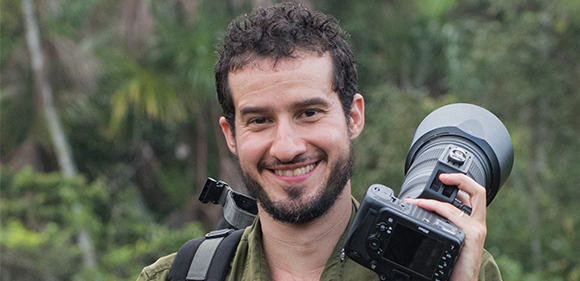The Future Leaders of Amphibian Conservation program is an award to a number of early-career conservationists from around the world that have been identified by the Amphibian Survival Alliance as the next generation of amphibian conservationists. So far we have awarded 19 Future Leaders from 12 countries (Bolivia, Brazil, Peru, Mexico, Ghana, South Africa, Uganda, India, Nepal, Pakistan, Australia and United States). You can learn more about some of the Future Leaders of Amphibian Conservation here.
Can you tell us about yourself, Pedro?
I am a biologist, focused on the discovery, documentation and protection of global biodiversity. I have dedicated most of my career to the systematics of Neotropical amphibians and lizards, and have named species from several places (mostly from Amazonia). I am also a nature photographer, with a special interest in the documentation of rare or endangered species. Most importantly, I am married and father of two beautiful kids.
What projects have you been involved in to promote amphibian conservation?
A while ago I had an idea to finally combine my scientific goals, enthusiasm for photography and passion for wildlife. I created the Documenting Threatened Species (DoTS) project, which is a bold initiative to study and document all amphibian species threatened with extinction in Brazil. I have dedicated a good portion of the last couple of years to this project, with a fair amount of success, but also many challenges. Brazil has 42 species officially listed as threatened, and we have already documented 13 of them, many of which are critically endangered. We have helped raise awareness about these species in Brazil but have also collected invaluable data on threats and infectious diseases in these species.
What is your favourite amphibian species and why?
There are probably too many and it is really hard to choose one, but I will try. I am really connected to the Restinga Toadlet (Melanophryniscus setiba). I discovered this species while still an undergraduate student in Brazil (around 2005 or 2006) and described it a few years later with colleagues and mentors. The species was formally described in 2012, and in 2014 was already included in the Brazilian list of threatened species, in the highest category (Critically Endangered). This species initiated both my career as an amphibian taxonomist, but also made me more aware of my duty, as a biologist and photographer, to do something for the conservation of animals and habitats. In January 2020 I had the opportunity to visit this species again in its natural habitat with DoTS. It was a magical moment when we found the animal there.
This is one of my favorite amphibians, but there are many others that I also like a lot. The Pará’s Lungless Salamander (Bolitoglossa paraensis) being one of very few salamanders in Brazil, is also one of my favorites. Finally, because of theirvbeauty, three other favorites are the Mapinguari Clown Treefrog (Den- dropsophus mapinguari), and the two critically endangered species, Spotted Casqueheaded Treefrog (Nyctimantis pomba) and Admirable Red-bellied Toad (Melanophryniscus admirabilis).
Has being recognized as a Future Leader of Amphibian Conservation by ASA made a difference in your career so far?
Absolutely yes! First and foremost, it gave me additional confidence to invest time and resources into conservation, and especially in the DoTS project. Moreover, I met several talented amphibian conservationists through ASA, which enabled me to participate in global discussions and initiatives about the conservation of amphibians.

